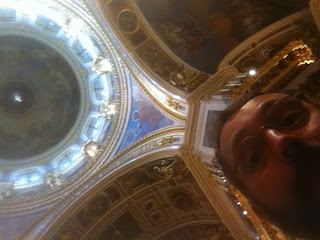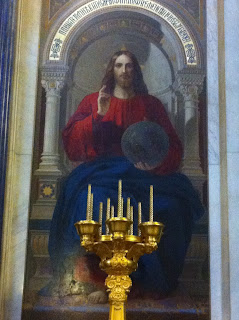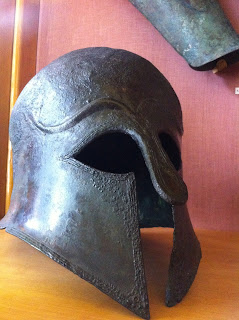I got into Berlin
in the late afternoon and grabbed a public bus to the Hauptbahnhof (I love
German - sounds much cooler than "train station")
 |
| Hauptbahnhof |
From there it was a
short cab ride to the Marriott I had used mileage to reserve. This hotel was directly
across from where the old Berlin Wall had been - when they tore down the wall,
they left inlaid stones in a permanent line tracking the entire course of the
Wall through the city. The hotel was
very close to "Checkpoint Charlie," which was the main entry point
for westerners wishing to visit East Berlin, (part of East Germany - generally
very unwelcoming to westerners) from West Berlin, an enclave in the middle of
East Germany (Look up enclave). For a time in 1962, just after the building of
the wall, the Soviets had attempted to stop American military personnel from
crossing the line, which was against the agreement the Big 4 leaders (who are
those guys??) had crafted. To their credit, Americans refused to submit to
checks and reinforced the doctrine that West Berlin
was free for Americans to travel in.
 |
| Berlin Wall in bad times - can you guess which side is the communist East side? |
 |
| Berlin Wall today - less imposing. In fact, looks similar to the wall protecting our southern border. |
But for a while American military police jeeps
escorted private cars at high alert so that they would not be detained. It was
sort of tense, like being a Broncos fan at a Raider game. Meanwhile the East
Germans and Russians were very serious about not letting East Germans leave East Berlin to the west. In one of the more tragic
examples, an 18-year old was shot just next to the wall on the eastern side.
Peter Fechter lingered for an hour before the communists retrieved him,
bleeding to death, Americans were forbidden to save him, as an international
incident could have led to a US-Soviet war. A monument now stands where he was
shot.
Back to Ancient History. I arose the next morning and ambled
my way over to the Pergamonmuseum, the place to which the Altar of Zeus from
the old Ionian Greek city of Pergamum
had been taken. (the people who went on the trip to Turkey
and Greece with me this summer saw the foundation, which is all that is now left
in Turkey - a fact they're a little sore about.) Now of course the Russians had
confiscated this temple after World War Two (are you getting the idea that
World War Two was kind of significant to European history?) but gave it back to
the loyal (to them) East Germans in 1954 or so. It's really quite a sight, substantially
restored, with a frieze of sculptures depicting the battle between the Giants
and Greek gods, as I've mentioned before.
 |
| One of the Greek goddesses about to clock a Giant. |
Now the German side of the story is this: the Christian
Byzantines sometime around 700 AD dismantled the pagan temple and used the
marble stones and sculptures to build the walls which defended the area from
threatening Muslims (unsuccessfully). By the 1800s the locals were scavenging
pieces of marble from the walls and burning them in kilns so they could use the
lime-rich ash as fertilizer. The German consul pressed the Ottoman government
to stop this and allowed him to take marble remnants to Berlin for reconstruction and preservation.
It's a much different story from the one I heard in Turkey and seems to be correct. The
Germans are absolutely convinced that there would be no Altar of Zeus had it
not been for them. It was a very interesting exhibit. Having just seen the exhibit
at the Pushkin in Moscow
showing what it might have looked like when new, it was really a great
experience.
But that wasn't all - the German archaeologists had also
reconstructed the Gate of Ishtar
from Babylon
from the original materials. It is a pretty awesome sight - one of my favorite
works of antiquity. Interesting to see it in the same space as the Altar of
Zeus - showing the advanced architecture of two great civilizations.
One more quick note of interest about East
Berlin . Some former East Berliners were a little non-plussed at
the superior attitude the West Berliners took towards everything about East Berlin . West Berliners wanted East Berlin to adapt
everything to be like West Berlin . This blew
up when Westberliners wanted to standardize the pedestrian stop-and-go signals
from eastberlin style to westberlin style. The Easterners had had enough and
refused to give up their beloved Ampelmann.
 |
| Beloved Ampelmann |
Finally all Berlin
has kept the Ampelmann and it has become the mascot for the nostalgia movement remembering
East Germany .
It's one of the most popular logos in Berlin ,
and for that matter, Germany .
Nuff bout that. I wrote some postcards and made it to the
Hauptbahnhof in time to catch my overnight train to Paris . Luckily no one else had booked a bed
in my three-sleeper cabin and I was able to sleep like a baby. The scenery was
beautiful and I arrived in Paris
a little late at 11am. The Louvre opens at 930am.











































